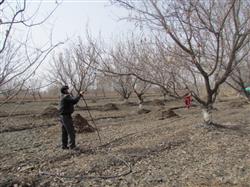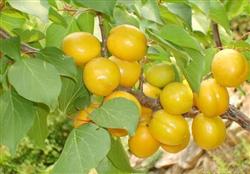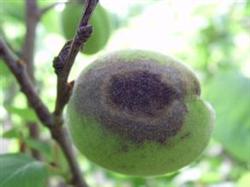Winter pruning of apricot trees

Apricot tree has the growth characteristics of secondary branching and tertiary branching. If it is allowed to grow, it will produce a lot of useless branches, resulting in closed crown and poor internal light, which will not only waste tree nutrition, but also cause a large number of flower development defects, seriously affecting apricot yield and quality. Winter pruning of apricot tree can play a role in concentrating tree nutrition, balancing tree vigor and increasing yield. I. Tree At present, the tree structure commonly used in production is mostly the main branch open layered shape, the tree structure is no trunk in the center, 4~6 main branches, the main branch adopts the back branch to change the head 3 times, in order to increase the opening angle of the branch, so that the main branch grows slightly obliquely upward. Each main branch has 5~6 lateral branches or large fruiting branch groups, which are divided into 2~3 layers and extend obliquely outward. Under the crown shape big on small, branch distribution is on sparse under dense, outside sparse dense, big branch sparse branchlets dense. The tree is characterized by strong backbone branches and vigorous growth potential. II. Winter pruning (1) Young trees and early fruiting trees Young trees and early fruiting apricot trees generally grow vigorously, crown expansion is rapid, new shoot growth is large, and often shoot two or three branches. This pruning period should give consideration to both shaping and fruiting. The main branch, branch extension branch to light cut long put, generally leave the whole branch length of 2/3 for short. Thinning crowded branches, cross branches, overlapping branches and strong branches disturbing tree shape, controlling competitive branches and upright branches. Apricot trees like light, in the shaping stage, pruning should pay attention to thinning the upper dense crowded branches, so that the crown bore ventilation and light transmission. For the moderate growth, angle relatively open development branch should be slow release, promote its germination short branch, increase the number of fruit branches, flower or fruit after timely retraction culture into fruit branch group. Medium and short branches have large angles and are easy to flower. They should be retained as much as possible to facilitate early fruit and high yield. For young trees with weak growth, it is appropriate to keep more branches, cut off more branches, thin and weak branches, keep more strong branches, flatten upright branches as auxiliary branches, and promote medium and short fruit branches. (2) The shaping task of apricot trees in full fruiting period has been basically completed. With the increase of tree age, the yield increased and gradually stabilized, the growth potential weakened, and the tree vigor gradually relaxed. The main task of pruning in this period is to maintain the relationship between rapid growth and fruiting, maintain tree vigor and prolong the fruiting period of full fruiting period. Pruning can be based on branch growth, crown of each part of the space situation, appropriate thinning, cutting weak, in order to maintain stable fruit parts and growth potential. For all levels of extended branches, generally short (cut off 1/3~2/3 of the current year's branches), so that it continues to shoot strong new shoots. For weak main branches, lateral branches, perennial auxiliary branches, fruiting branch groups and drooping branches, retract and renew or raise the angle at the parts with strong branches to restore their growth potential. For the lower part of the crown and the inner bore, the length of the extension head of the branch, the auxiliary branch and each branch group should be staggered during pruning, and the space before and after should be fully utilized. The lower inclined branches should be appropriately truncated to keep them healthy and gradually cultured into branch groups. Raise the angle of retraction of skirt branches under crown. For the lower layer of the back branch as far as possible to stay straight oblique, change the direction, the back of the branch group selected to stay strong, stay short, and should not be too, in order not to affect the light for the principle. For the dorsal branches, if there is space, remove the weak and leave the strong, and if there is no space, remove it. For the short branches in the middle and lower part of the crown, due to its complete flowers and strong fruit setting, it should be left more appropriately and pay attention to timely renewal and rejuvenation. The dense branches and strong branches in the upper part and periphery of the crown were retracted or thinned to improve the light in the bore. If there is room, pull the strong branches, upright branches and auxiliary branches to make them moderate fruit branches and increase the fruit position. Apricot branch force is weak, as long as it is not too dense, generally do not thin out, can be truncated to promote a small number of long branches, promote the middle and lower part of the short branch alternate results. (3) Senescence period During senescence period, apricot tree extended branches weakened, new shoots became short, trunk branches began to droop, crown interior began to bare, almost only on the outer surface of the crown fruit, yield and quality decreased. The main tasks of pruning in this period are to renew the trunk branches and branch groups, strengthen and restore the tree vigor, and prolong the economic fruiting life. To use the angle of the lower and middle small, strong growth of the back branch to change the head, or in the more upright branch on the retraction, promote the germination and renewal of hidden buds. The excessive long branches in proper position were cultured into main branches and fruiting branches by pulling branches, cutting short branches and pinching in summer. For fruiting branch group and fruiting branch, in line with the principle of "removing weak and leaving strong", strong branches and buds are selected for renewal pruning. For those trees with extremely weak vigor and difficult regeneration, under the premise of strengthening fertilizer and water management, the main branches and large branch groups can be regenerated in 10~15 years old, and a large number of new branches can sprout in the same year; through summer bud removal, topping and winter pruning, the second year can bear fruit, and the third year can recover a certain yield.
- Prev

Techniques of fertilization and Irrigation Management of Apricot
(1) after the new shoots stopped growing from September to October every year, sufficient basal fertilizer was applied, mainly organic fertilizer such as stable manure and chicken manure, combined with a certain amount of quick-acting fertilizer. the amount of fertilizer should be determined according to the size and growth of the tree, usually 30 kilograms of organic fertilizer per plant, plus about 0.5 kilograms of special compound fertilizer for fruit trees. Cute.
- Next

The management of apricot trees after fruit picking should keep up
Symptoms Apricot brown rot has two symptoms. A harmful near-mature fruit, initially forming dark brown, slightly depressed round lesions, then rapidly expanding, soft rot, with yellow-brown velvety particles, whorled or irregular, damaged fruit more early fall off, rot, a few hanging on trees to form dead fruit. Another harmful fruit...
Related
- Moge, come on! The staff of the peasant association in the producing area of cantaloupe were frightened when the crowd gathered.
- Causes and Solutions of low Fruit setting rate of Apple
- Symptoms and control measures of passion fruit virus disease
- Fruit growing lesson: how do apple orchards keep high yields?
- Can you build orchards in the mountains? What are the pros and cons?
- How to manage the coloring period of Crisson grape?
- This paper introduces the processing technology of two kinds of fig products.
- How much is a month for retired teachers in rural areas by 2020?
- How can strawberry planting increase sugar content? We should pay attention to management in many aspects.
- What are the cultivation techniques on how to improve the yield of golden fruit?

